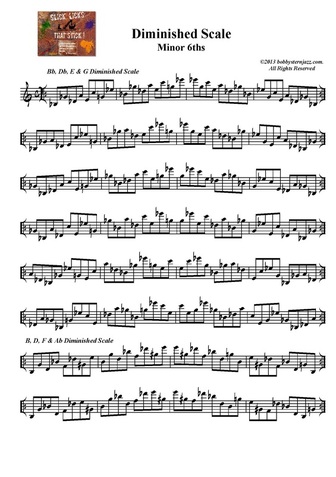
The diminished scale, as you may know (or maybe you don't), is an 8 note symmetrical scale. It's construction can be viewed as:
- alternating whole and half tones, a 2 note pattern which repeats itself 4 times per octave, thus dividing the octave into 4 equal parts, each consisting of a minor third. This division creates 3 distinct diminished scales (2 per note).
- e.g. Whole tone/ Half tone (C-D) (Eb-F) (F#-G#) (A-B). Half tone/ whole tone (Auxiliary diminished): (C-Db) (Eb-E) (F#-G) (A-Bb).
- 2 diminished seventh chords, a whole step or half step apart (C-Eb-Gb-A, D-F-Ab-B) or (C-Eb-Gb-A, C#-E-G-Bb).
- 4 minor or Major triads, a minor third apart (C, Eb, F#, A Maj. / min triads).
The interval of a minor 6th (b6th) is not found in any diminished chord, but as an inverted Maj. 3rd, it lends itself to the Major tonalities inherent in the diminished scale. As each line of this exercise, created by b6ths, moves in different directions, there are different and interesting multi-note tonal combinations formed.
For example: in line one, the first 3 notes (Bb, Gb & Db), create a 1st inversion Gb Maj. triad, The second 3 notes (A, E & C) make up an disjunct A min. triad. So you'd be emphasizing these two Maj. /min. colors, if you played the exercise as eighth note triplets.
The 4 note groupings in line one, (2 ascending minor 6ths, a minor third apart) create a Maj. triad, 1st inversion with a #9 on top. This 4 note combination can also be found in the augmented scale.
Check out some 5 and 6 note groupings, as well.
 RSS Feed
RSS Feed









